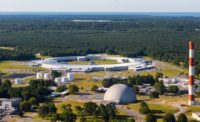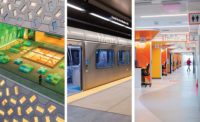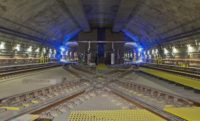The adaptive-reuse 100 Van Ness project transformed an outdated 29-story office building into a modern apartment community offering 418 units and many indoor and outdoor amenities in San Francisco’s Mid-Market neighborhood. The reconfiguration swapped an old precast-concrete wall system with a new unitized curtain wall, which softened the building’s oppressive exterior.
Removing 1,600 precast-concrete panels presented significant safety challenges due to the building’s height, busy downtown location and a number of nearby historic buildings. But the hefty weight of the panels—from 7,000 to 14,000 lbs each—presented the project team with its biggest hurdle.
First, demolition crews chipped away concrete from the precast anchor plates. Then, they rigged each panel to a tower crane, at which point welders torched the bolts to sever the connection. Next, a mini-excavator pushed the panel away from the building, and the tower crane lowered it onto a waiting truck, which hauled everything away for recycling.
The team removed, on average, one panel every fifteen minutes. The entire removal process took six months.
Judges praised the project’s safety culture. “Safety preplanning during preconstruction all the way through construction was a team effort with full buy-in and consistent management on a daily basis,” said one juror. “The effort was intense and paid big dividends with no lost-time accidents.”
For the duration, crews were cognizant “that the last panel is just as dangerous as the first one,” says Paula Prichard, project executive and vice president with general contractor Plant Construction Co. “We had to worry about the monotony of it because there were a lot of panels over a long period of time.”
The tower’s proximity to a high-pressure gas line precluded a traditional crane foundation. Therefore, the 500-ft-tall tower crane was mounted on two 20,000-lb steel beams that cantilevered from the building structure into the adjacent street—a first for San Francisco. The beams attached to a frame that penetrated through three basement levels of parking into the building’s foundation. Since the project’s completion in April 2015, the crane design has been adopted and used on subsequent Bay Area projects.
While means-and-methods engineering typically would be outsourced by the contractor, in this case the owner’s engineer wanted ownership of the crane foundation design so that it worked with the building, Prichard says.
The tower required no seismic retrofit—unusual for a renovation of a San Francisco building more than 40 years old—because the original structure had been designed for the old precast panels, which imposed much heavier loads than the new glazing system.
The project design also reorganized interior floors to create open, airy living spaces with expansive views of the city. Crews removed mechanical shafts, core bathrooms and six unneeded elevator shafts, turning the square footage into rentable space. Interior spaces feature clerestory windows and partially opaque sliding-door systems, allowing light to penetrate deep into each apartment.
A dramatic roof deck provides residents with 360° views of the Bay Area, along with garden space, a grass lawn, lounges, a fire pit and a grilling area. The building earned a GreenPoint certification due to its adaptive reuse of the existing structure and high-performance curtain wall.
“I want to live there, quite honestly,” said one judge. “It’s quite an accomplishment.”
100 Van Ness
San Francisco Region California
Project Team
Owner Emerald Fund + NREA
Lead Design Firm Solomon Cordwell Buenz
Contractor Plant Construction Co. L.P.
Structural Engineer Nishkian Menninger
Civil Engineer BKF Engineers
MEP Engineer, Lighting Design WSP Group
Interior Design McCartan
Curtain-wall Consultant Arup North America
Subcontractors Stomper Co., Architectural Glass and Aluminum, and Morrow Equipment Co.








Post a comment to this article
Report Abusive Comment